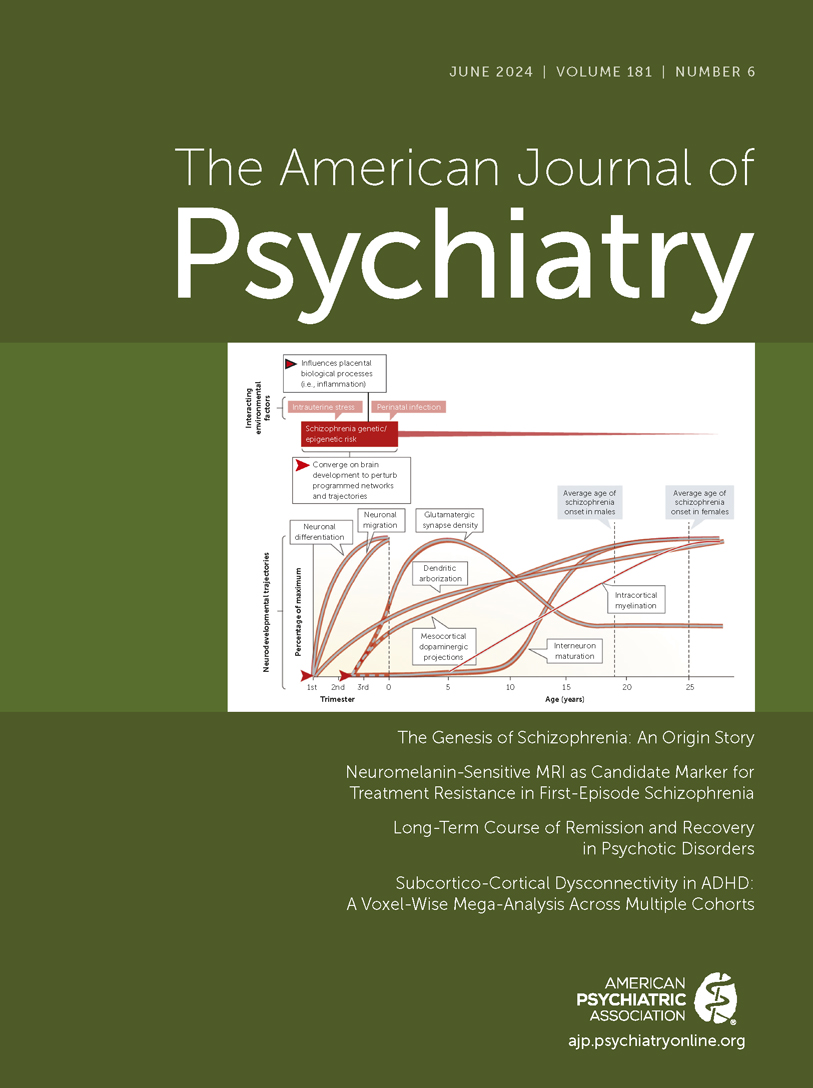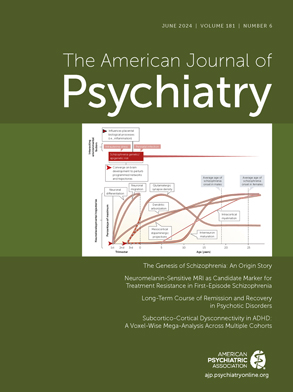Approximately one-third of patients with schizophrenia do not receive meaningful benefits from first-line antipsychotics (
1). When this occurs despite two or more adequate treatment episodes with different antipsychotics, it is termed treatment-resistant schizophrenia (
1). Treatment-resistant schizophrenia is associated with reduced quality of life and substantial economic cost to the individual and society (
2). Clozapine is the only licensed medication for treatment-resistant schizophrenia, and early use is linked to markedly improved outcomes (
3). However, currently the only way to identify treatment resistance is through a series of therapeutic trials with first-line antipsychotics, which often delays clozapine treatment by years, exposes patients to side effects and other risks, and increases costs (
4). Treatment of schizophrenia would be revolutionized if we had a biomarker to allow for the early identification of patients with treatment-resistant schizophrenia.
Schizophrenia is associated with mesostriatal hyperdopaminergia (
5), and first-line antipsychotics exert their therapeutic effects by blocking striatal dopamine transmission (
6). This makes the dopaminergic system an obvious candidate biomarker for treatment resistance. Dopamine function can be efficiently measured using [
18F]-DOPA positron emission tomography (PET). This technique has repeatedly been used to demonstrate that striatal dopamine synthesis capacity in people with antipsychotic treatment resistance or nonresponsive schizophrenia is lower than in those with responsive illness (
7–
10), and either lower than (
7,
10) or comparable to (
8,
9) healthy control subjects. It has been demonstrated that 40%–60% of nonresponders in a schizophrenia cohort (N=84) could be identified, without mislabeling a single treatment responder, by low striatal dopamine synthesis capacity alone (
7). Using this model to fast-track clozapine initiation could potentially lead to health care savings of US$4,232 per patient (
7). However, PET measures are limited by radiotracer availability.
Neuromelanin is a product of dopamine metabolism that can be indexed in vivo using neuromelanin-sensitive MRI (NM-MRI) without the need for a radiotracer or contrast agent (
11). These factors, combined with the wide availability of MRI scanners, are potential advantages over PET. Early NM-MRI studies in schizophrenia outlined dopaminergic nuclei by manually tracing around the high signal area in the ventral midbrain. Naming of this region has been inconsistent, so we will use the term substantia nigra and ventral tegmental area (SN-VTA) throughout, given that these adjacent tissues cannot currently be distinguished using NM-MRI. The primary outcome measure from most previous studies was the SN-VTA contrast ratio (CR), calculated by comparing the mean NM-MRI signal in the SN-VTA with the signal in a reference region of minimal neuromelanin content (e.g., the crus cerebri). Meta-analysis of case-control NM-MRI studies has demonstrated greater SN-VTA CR in schizophrenia patients relative to healthy control subjects (
12), but no previous studies have compared CR in people with treatment-resistant or nonresponsive schizophrenia to those with responsive illness.
Given this context, the study by van der Pluijm et al. (
13) in this issue of the
Journal, investigating the ability of NM-MRI to predict treatment response in schizophrenia, is particularly timely. The authors used NM-MRI of the SN-VTA in patients with first-episode psychosis and matched healthy control subjects. As per the naturalistic design, patients received antipsychotic treatment based on standard guidelines by their treating psychiatrist. At 6 months, patients were reassessed and classified as treatment nonresponders or responders, and a follow-up NM-MRI scan was performed. Patients also received clinical ratings on the Positive and Negative Syndrome Scale (PANSS).
Of the 62 patients included in the NM-MRI analysis, 47 were responders and 15 nonresponders to first-line antipsychotic treatment. Twenty matched healthy control subjects underwent baseline NM-MRI. Of the patient group, 37 also had a follow-up NM-MRI. Voxel-wise analysis revealed that 297 of 1,807 SN-VTA voxels, predominantly in the ventral SN-VTA, were associated with significantly higher CR for responders compared with nonresponders. While there was a group effect on the mean whole SN-VTA CR (p=0.02), there was no significant difference in values between any two groups. Identifying nonresponders by low CR in the voxel-wise analysis had moderate diagnostic ability (leave-one-out area under the curve=0.62; whole SN-VTA area under the curve=0.68).
Strengths of this paper include its being the first to compare NM-MRI across treatment response groups and identifying voxels of significant difference. The authors used a processing pipeline for which correlation between CR and regional neuromelanin concentration had been validated on postmortem midbrain specimens (
14). Patients were recruited early in their illness, most within several weeks of an inpatient admission. This, alongside a limited period of medication use prior to baseline scanning, reduced the risk of confounding effects related to illness duration or prior treatment. The authors obtained a relatively large sample size for this type of study, likely adequately powered to assess the primary hypothesis.
The use of a voxel-wise approach instead of analyzing CR for a predefined SN-VTA region of interest has some advantages. Because the region-wise approach gives equal weighting to each masked voxel, it cannot examine subregion differences. These differences may be important given the heterogeneous nature of SN-VTA dopamine function. Masks are kept small to reduce the risk of including non-region voxels at the expense of omitting voxels where group differences could be seen. These limitations may account for the modest patient-control effect size demonstrated on meta-analysis of previous region-of-interest studies (standardized mean difference=0.37, 95% CI=0.14, 0.59) (
12). This is notably lower than effect sizes associated with striatal [
18F]-DOPA PET studies (standardized mean difference=0.79, 95% CI=0.52, 1.07) (
5). As the voxel-wise approach can confine analysis to significant voxels within the mask, it may have greater power to detect group differences. This also means that larger masks can be used to capture more of the region with less effect of nonsignificant voxels on the final results.
While voxel-wise analyses have issues with reproducibility, extensive work by the Horga Lab and collaborators has addressed many of these issues. The current pipeline uses parameters found to have reasonable reliability on testing (
15) and also includes a method of cross-scanner harmonization (
16), which has allowed comparison of results across sites in New York City and Mexico City (
17).
The van der Pluijm et al. study also has noteworthy limitations. While patients were scanned early in their illness, they were not in the acute phase, as evidenced by the relatively low PANSS scores, across both groups, equating to psychotic symptoms of mild or moderate severity on average. Additionally, most had already shown some response to first-line antipsychotics at baseline. As is to be expected, nonresponders had significantly higher baseline PANSS scores across all domains than responders. As moderate psychotic symptoms have been linked to increased head movement and altered MRI results (
18), measuring and controlling for group-level movement differences could ensure that this covariate is not biasing findings. The optimization of the authors’ pipeline for voxel-wise analysis may make it difficult to compare findings with previous studies that only used a whole-region approach. For example, to reduce the already discussed limitations associated with the whole-region approach, their SN-VTA mask was made deliberately overinclusive, at 1,807 voxels, much larger than the California Institute of Technology atlas, at 982 voxels for the same region (
19). This may explain why none of the previous schizophrenia-control studies using the present study’s analysis pipeline have demonstrated increased whole SN-VTA CR in schizophrenia patients relative to control subjects (
13,
14,
17).
An additional caveat should be considered before assuming generalizability. The voxel-wise analysis involved identifying voxels of interest based on voxels where the difference in treatment response status between responders and nonresponders was greatest. The prediction analysis then used the mean CR of these voxels for treatment response prediction. As pointed out by the researchers, this is an example of using an initial step to enrich the data used for the prediction analysis, referred to as “double-dipping.” This risks inflating diagnostic or prediction metrics as a result of statistical circularity (
20). While the authors used a leave-one-out cross-validation approach to correct for this, recent work has highlighted that accuracy is likely to fall further when applied to novel samples (
21). This, alongside the relatively low sample size of nonresponders (N=15), means that caution must be used in inferring the clinical utility of NM-MRI for predicting treatment response from the study results.
The study has also provided further insights into the neurobiology of schizophrenia by identifying the ventral SN as a key location for identifying treatment response. It is also the ventral SN-VTA CR that has been associated with dopamine release capacity in the associative striatum (
14) and with symptom severity in schizophrenia (
14,
17). Dopamine neurons in the ventral SN-VTA project to the head of the caudate nucleus and the anterior putamen, termed the associative striatum (
22). Therefore, these findings add to the literature supporting hyperdopaminergia of the associative mesostriatal pathway as the locus of dysfunction in treatment-responsive schizophrenia (
23).
Notwithstanding the issues considered above, the study by van der Pluijm et al. is an important step forward in understanding the neurobiology of treatment resistance and identifying a biomarker to aid its early diagnosis. Combining NM-MRI with other neuroimaging procedures could help to elucidate pathoetiology and disease-specific treatment targets. Alongside this, large multicenter studies using the same study pipeline could assess the generalizability of their impressive findings.

